Broadcasting Winter Wheat Can Increase Grain Yield without Reducing the Kernels per Spike and the Kernel Weight
Abstract
:1. Introduction
2. Materials and Methods
2.1. The Experimental Site
2.2. The Experimental Design
2.3. Measurements
2.3.1. The Leaf Area Index (LAI)
2.3.2. The Mean Leaf Inclination Angle (MLIA)
2.3.3. Plant Height Component Index (PHCI)
2.3.4. Dry Matter Accumulation (DMA)
2.3.5. Yield and Yield Components
2.3.6. Stand Uniformity
2.4. Statistical Analysis
3. Results
3.1. Weather Conditions
3.2. Emergence and Seedling
3.3. Winter Wheat Growth and Development
3.4. Tiller Development
3.5. Dry Matter Accumulation
3.6. Yield and Yield Components
4. Discussion
4.1. Stand Uniformity
4.2. Uniformity Can Facilitate a Reasonable Canopy Structure with a More Uniform Distribution of Leaves in the Canopy
4.3. More Tillers Obtained When the Stand Was Uniform
4.4. BSS Can Improve Grain Yield without Reducing Kernel per Spike and Kernel Weight
4.5. Stand Uniformity Can Facilitate Reproductive Relocation
4.6. Seedlings
4.7. The Variety
5. Conclusions
Author Contributions
Funding
Acknowledgments
Conflicts of Interest
References
- Wu, D.; Yu, Q.; Lu, C.; Hengsdijk, H. Quantifying production potentials of winter wheat in the North China Plain. Eur. J. Agron. 2006, 24, 226–235. [Google Scholar] [CrossRef]
- Chen, S.Y.; Zhang, X.Y.; Sun, H.Y.; Shao, L.W. Cause and mechanism of winter wheat yield reduction under straw mulch in the North China Plain. Chin. J. Eco-Agric. 2013, 21, 519–525. [Google Scholar] [CrossRef]
- Qin, H.L.; Gao, W.S.; Yue-Cun, M.A.; Li, M.A.; Yin, C.M. Effects of Subsoiling on Soil Moisture under No-tillage 2 Years Later. Sci. Agric. Sin. 2008, 7, 88–95. [Google Scholar]
- Meirong, L.; Li, Z.; Zhang, T.; Ning, T.; Zhao, J.; Li, H. Effects of minimum or no-tillage system and straw returning on extreme soil moisture and yield of winter wheat. Trans. Chin. Soc. Agric. Eng. 2010, 26, 41–46. [Google Scholar]
- BlancoCanqui; DeClerck; Gatere, Conservation agriculture and ecosystem services: An overview. Agric. Ecosyst. Environ. 2014, 187, 87–105. [CrossRef]
- Li, Y.; Wu, J.; Ming, H.; Yao, Y.; Zhang, C.; Cai, D.; Ke, J. Effects of different tillage systems on photosynthesis characteristics of flag leaf and water use efficiency in winter wheat. Trans. Chin. Soc. Agric. Eng. 2006, 22, 44–48. [Google Scholar]
- Han, B.; Li, Z.; Yun, W.; Ning, T.; Zheng, Y.; Shi, Z. Effects of soil tillage and returning straw to soil on wheat growth status and yield. Trans. Chin. Soc. Agric. Eng. 2007, 23, 48–53. [Google Scholar]
- Zheng, C.Y.; Cui, S.M.; Dong, W.; Zhen-Wen, Y.U.; Zhang, Y.L. Effects of Soil Tillage Practice on Dry Matter Production and Water Use Efficiency in Wheat. Acta Agron. Sin. 2011, 37, 1432–1440. [Google Scholar] [CrossRef]
- Bian, C.; Ma, C.; Liu, X.; Chao, G.; Liu, Q.; Yan, Z.; Ren, Y.; Li, Q. Responses of Winter Wheat Yield and Water Use Efficiency to Irrigation Frequency and Planting Pattern. PLoS ONE 2016, 11, e0154673. [Google Scholar] [CrossRef] [PubMed]
- Liu, Z.; Qin, A.; Zhao, B.; Ata-Ul-Karim, S.T.; Xiao, J.; Sun, J.; Ning, D.; Liu, Z.; Nan, J.; Duan, A. Yield Response of Spring Maize to Inter-Row Subsoiling and Soil Water Deficit in Northern China. PLoS ONE 2016, 11, e0153809. [Google Scholar] [CrossRef] [PubMed]
- Xue, Y.; Zhang, Y.; Huang, Q. Effects of nar-row row spacing and uniform sowing on canopy environment, individualplant traits, and biomass production in late-sowing winter wheat. Acta Ecol. Sin. 2015, 35, 5545–5555. [Google Scholar]
- Zhao, D.; Shen, J.; Lang, K.; Liu, Q.; Li, Q. Effects of irrigation and wide-precision planting on water use, radiation interception, and grain yield of winter wheat in the North China Plain. Agric. Water Manag. 2013, 118, 87–92. [Google Scholar]
- Fasoula, D.A.; Fasoula, V.A. Competitive ability and plant breeding. In Plant Breeding Reviews; John Wiley & Sons, Inc.: New York, NY, USA, 1997; pp. 89–138. [Google Scholar]
- Chen, C.; Karnes, N.; Dave, W.; Malvern, W. Hard Red Spring Wheat Response to Row Spacing, Seeding Rate, and Nitrogen. Agron. J. 2008, 100, 1296–1302. [Google Scholar] [CrossRef]
- Kristensen, L.; Olsen, J.; Weiner, J.; Griepentrog, H.W.; Nørremark, M. Describing the spatial pattern of crop plants with special reference to crop–weed competition studies. Field Crops Res. 2006, 96, 207–215. [Google Scholar] [CrossRef]
- Zhai, Y.; Wei, Y.; Zhang, H.L.; Chen, F. Effect of seeding and tillage methods on population quality and yield of winter wheat in North China. J. Triticeae Crop. 2016, 36, 1174–1182. [Google Scholar]
- Wei, X.; Wu, C.S. Architectural Analysis of Plant Height of Common Wheat (Triticum aestivum L.). J. Nanjing Agric. Univ. 1983, 1, 13–21. [Google Scholar]
- Weiner, J.; Stoll, P.; Muller-Landau, H.; Jasentuliyana, A. The effects of density, spatial pattern, and competitive symmetry on size variation in simulated plant populations. Am. Nat. 2001, 158, 438–450. [Google Scholar] [CrossRef]
- Schwinning, S.; Weiner, J. Mechanisms determining the degree of size asymmetry in competition among plants. Oecologia 1998, 113, 447–455. [Google Scholar] [CrossRef]
- Ford, J.H.; Hicks, D.R. Corn Growth and Yield in Uneven Emerging Stands. J. Prod. Agric. 1992, 5, 185. [Google Scholar] [CrossRef]
- Tollenaar, M.; Dwyer, L. Physiology of maize. In Crop Yield; Springer: Salmon Tower Building, NY, USA, 1999; pp. 169–204. [Google Scholar]
- Gautam, P.; Xue, Q.; Jessup, K.E.; Rudd, J.C.; Liu, S.; Mahan, J.R. Cooler Canopy Contributes to Higher Yield and Drought Tolerance in New Wheat Cultivars. Crop Sci. 2014, 54, 2275–2284. [Google Scholar]
- Palut, M.P.J.; Canziani, O.F. Contribution of Working Group II to the Fourth Assessment Report of the Intergovernmental Panel on Climate Change; Cambridge University Press: Cambridge, UK, 2007. [Google Scholar]
- Kristensen, K.; Schelde, K.; Olesen, J.E. Winter wheat yield response to climate variability in Denmark. J. Agric. Sci. 2011, 149, 33–47. [Google Scholar] [CrossRef]
- Trnka, M.; Rötter, R.P.; Ruiz-Ramos, M.; Kersebaum, K.C.; Olesen, J.E.; Žalud, Z.; Semenov, M.A. Adverse weather conditions for European wheat production will become more frequent with climate change. Nat. Clim. Chang. 2014, 4, 637. [Google Scholar] [CrossRef]
- Hussain, M.; Mehmood, Z.; Khan, M.B.; Farooq, S.; Dong-Jin, L.; Farooq, M. Narrow row spacing ensures higher productivity of low tillering wheat cultivars. Int. J. Agric. Biol. 2012, 14, 413–418. [Google Scholar]
- Smith, H. Physiological and Ecological Function within the Phytochrome Family. Annu. Rev. Plant Physiol. Plant Mol. Biol. 2003, 46, 289–315. [Google Scholar] [CrossRef]
- Smith, H.; Whitelam, G.C. The shade avoidance syndrome: Multiple responses mediated by multiple phytochromes. Plant Cell Environ. 2010, 20, 840–844. [Google Scholar] [CrossRef]
- Casal, J.J.; Sanchez, R.A.; Deregibus, V.A. The effect of plant density on tillering: The involvement of R/FR ratio and the proportion of radiation intercepted per plant. Environ. Exp. Bot. 1986, 26, 365–371. [Google Scholar] [CrossRef]
- Satter, R.L.; Wetherell, D.F. Photomorphogenesis in Sinningia speciosa, cv. Queen Victoria II. Stem Elongation: Interaction of a Phytochrome Controlled Process and a Red-Requiring, Energy Dependent Reaction. Plant Physiol. 1968, 43, 961–967. [Google Scholar] [CrossRef]
- Casal, J.J.; Sanchez, R.A.; Gibson, D. The Significance of Changes in the Red/Far-Red Ratio, Associated with Either Neighbour Plants or Twilight, for Tillering in Lolium multiflorum Lam. New Phytol. 1990, 116, 565–572. [Google Scholar] [CrossRef]
- Ballaré, C.L.; Sánchez, R.A.; Scopel, A.L.; Casal, J.J.; Ghersa, C.M. Early detection of neighbour plants by phytochrome perception of spectral changes in reflected sunlight. Plant Cell Environ. 2010, 10, 551–557. [Google Scholar]
- Simon, M. Inheritance of flag-leaf angle, flag-leaf area and flag-leaf area duration in four wheat crosses. Theor. Appl. Genet. 1999, 98, 310–314. [Google Scholar] [CrossRef]
- Thorne, G. Physiological factors limiting the yield of arable crops. In Potential Crop Production, A Case Study; Wareing, P.F., Cooper, J.P., Eds.; Heinemann Educational Books Limited: London, UK, 1971. [Google Scholar]
- Borojevic, S.; Cupina, T.; Krsmanovic, M. Green area parameters in relation to grain yield of different wheat genotypes. Z. Pflanzenzucht. 1980, 84, 265–283. [Google Scholar]
- Wells, R. Soybean growth response to plant density: Relationships among canopy photosynthesis, leaf area, and light interception. Crop Sci. 1991, 31, 755–761. [Google Scholar] [CrossRef]
- Álvaro, F.; Isidro, J.; Villegas, D.; García del Moral, L.F.; Royo, C. Breeding effects on grain filling, biomass partitioning, and remobilization in Mediterranean durum wheat. Agron. J. 2008, 100, 361–370. [Google Scholar] [CrossRef]
- Shearman, V.J.; Sylvester-Bradley, R.; Scott, R.K.; Foulkes, M.J. Physiological processes associated with Wheat Yield Progress in the UK. Crop Sci. 2005, 45, 175–185. [Google Scholar]
- Meng, Q.; Yue, S.; Chen, X.; Cui, Z.; Ye, Y.; Ma, W.; Tong, Y.; Zhang, F. Understanding dry matter and nitrogen accumulation with time-course for high-yielding wheat production in China. PLoS ONE 2013, 8, e68783. [Google Scholar] [CrossRef] [PubMed]
- Glenn, F.; Daynard, T. Effects of genotype, planting pattern, and plant density on plant-to-plant variability and grain yield of corn. Can. J. Plant Sci. 1974, 54, 323–330. [Google Scholar] [CrossRef]
- Pan, X.; Wang, G.; Chen, J.; Wei, X. Elevated growth redundancy and size inequality in spring wheat populations mulched with clear plastic film. J. Agric. Sci. 2003, 140, 193–204. [Google Scholar] [CrossRef]
- Jessop, R.S.; Stewart, L.W. Effects of crop residues, soil type and temperature on emergence and early growth of wheat. Plant Soil 1983, 74, 101–109. [Google Scholar] [CrossRef]
- Cochran, V.L.; Elliott, L.F.; Papendick, R.I. Effect of Crop Residue Management and Tillage on Water Use Efficiency and Yield of Winter Wheat 1. Agron. J. 1982, 74, 929–932. [Google Scholar] [CrossRef]
- Su-Juan, L.I.; Ji-Kang, C.H.; Fu, C.; Lin, L.I.; Zhang, H.L. Characteristics of growth and development of winter wheat under zero tillage in North China Plain. Acta Agron. Sin. 2008, 34, 290–296. [Google Scholar]
- Fanlei, K.; Jichao, Y.; Hailin, Z. Effect of tillage practice on growth and development and yield of winter wheat in double cropping area in North China. Acta Agron. Sin. 2013, 39, 1612–1618. [Google Scholar]
- Olsen, J.M.; Griepentrog, H.W.; Nielsen, J.; Weiner, J. How Important are Crop Spatial Pattern and Density for Weed Suppression by Spring Wheat? Weed Sci. 2012, 60, 501–509. [Google Scholar] [CrossRef]
- Hol, W.H.G.; Boer, W.D.; Hooven, F.T.; Putten, W.H.V.D. Competition Increases Sensitivity of Wheat (Triticum aestivum) to Biotic Plant-Soil Feedback. PLoS ONE 2013, 8, e66085. [Google Scholar] [CrossRef] [PubMed]
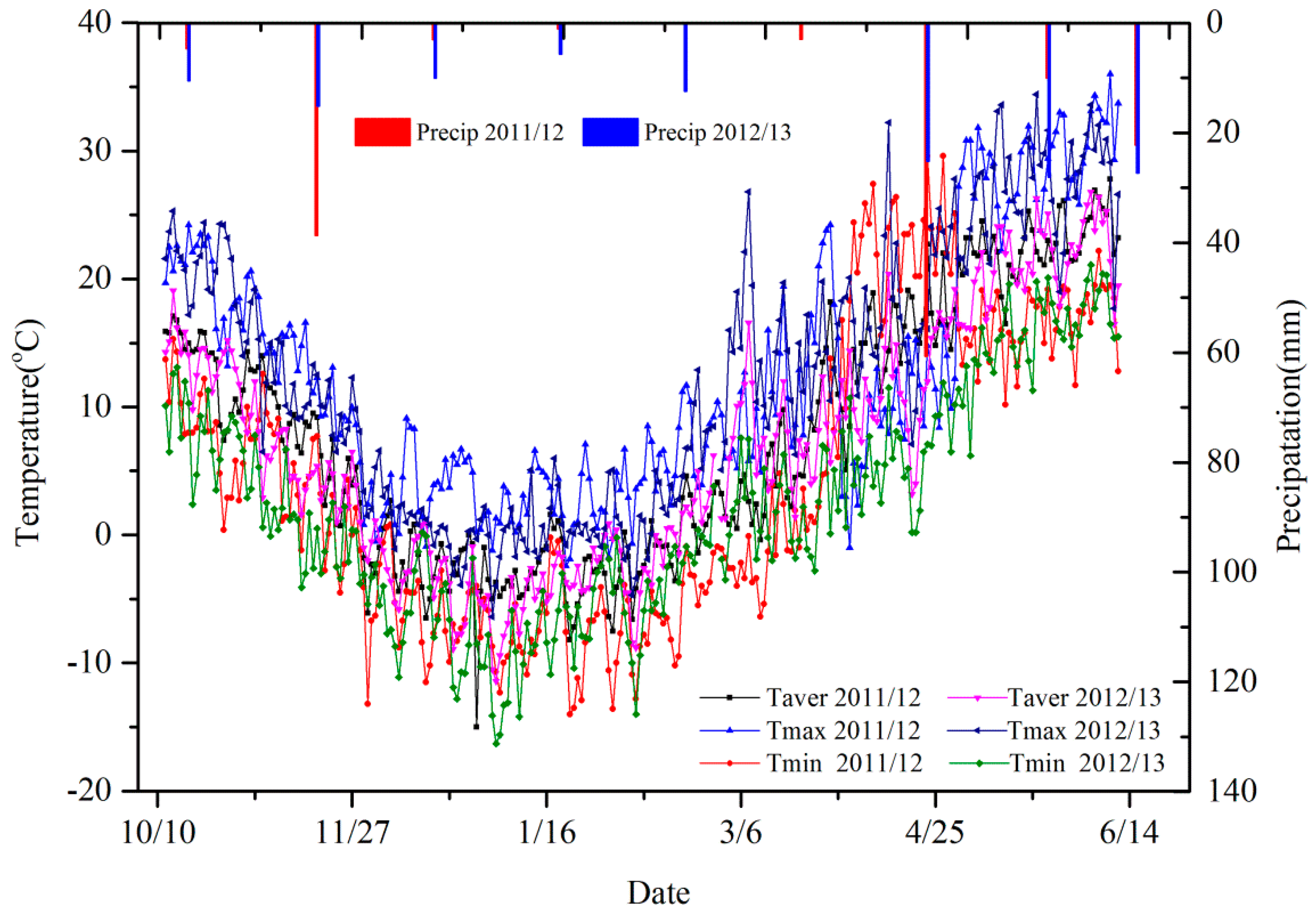
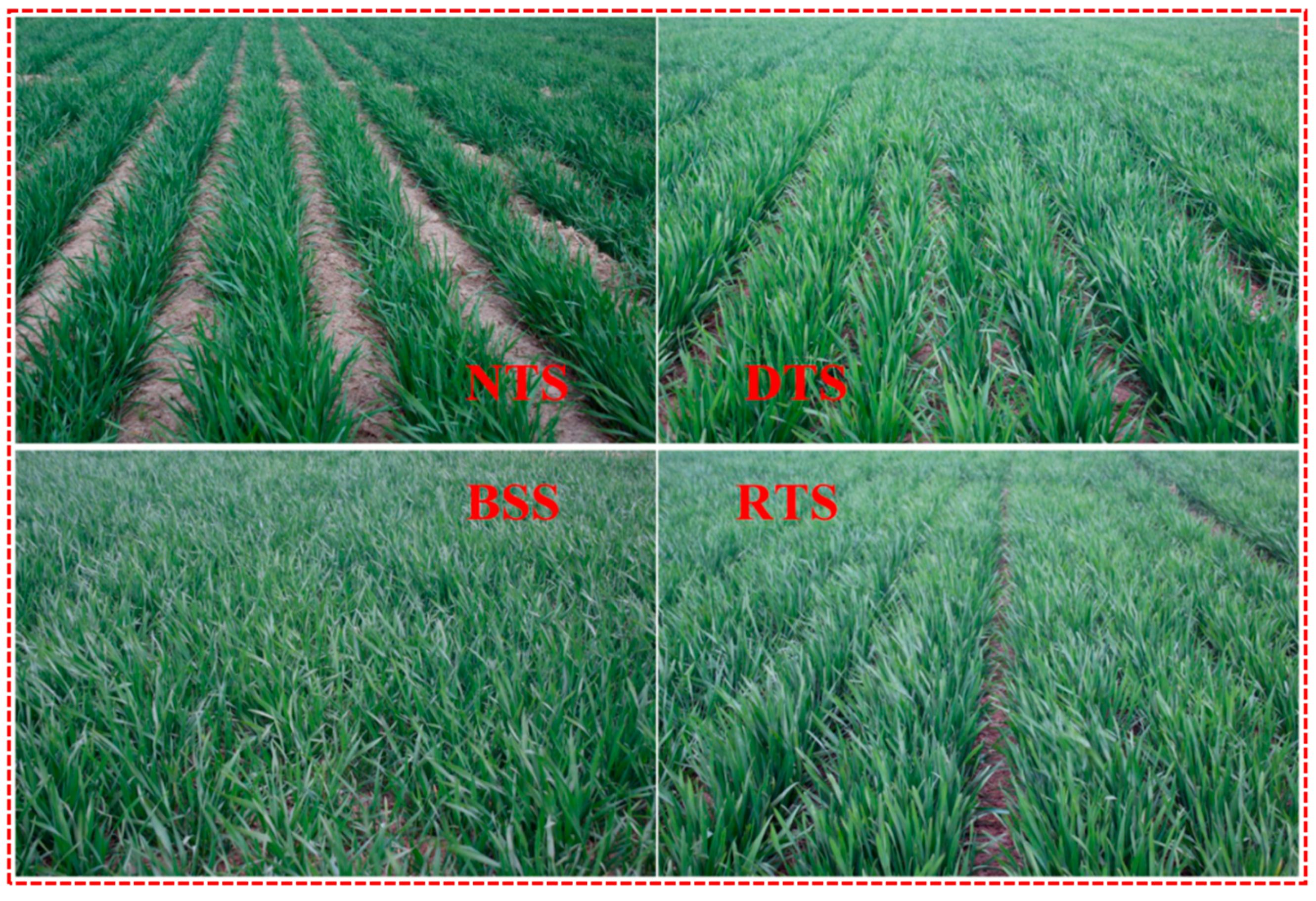
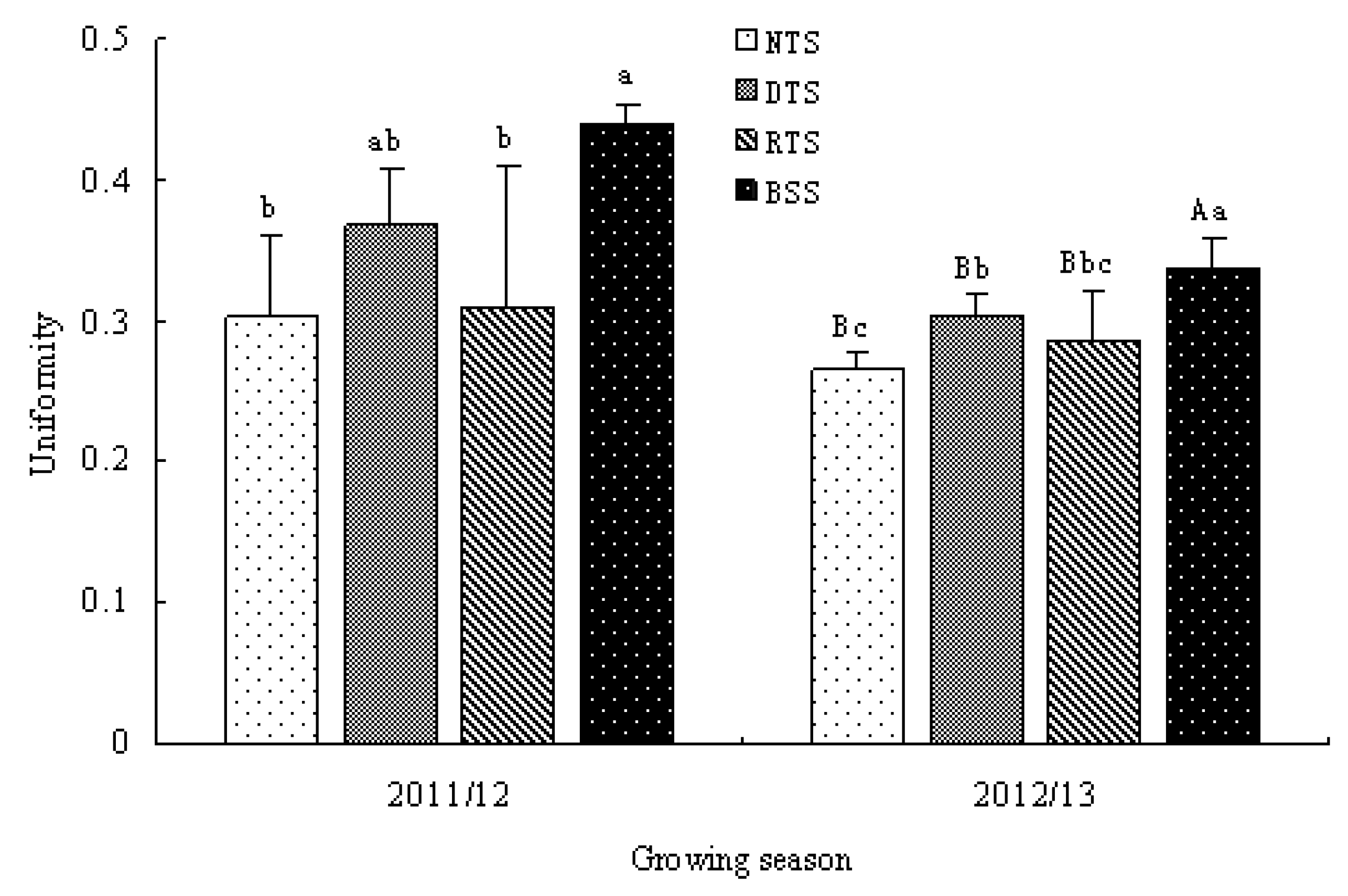

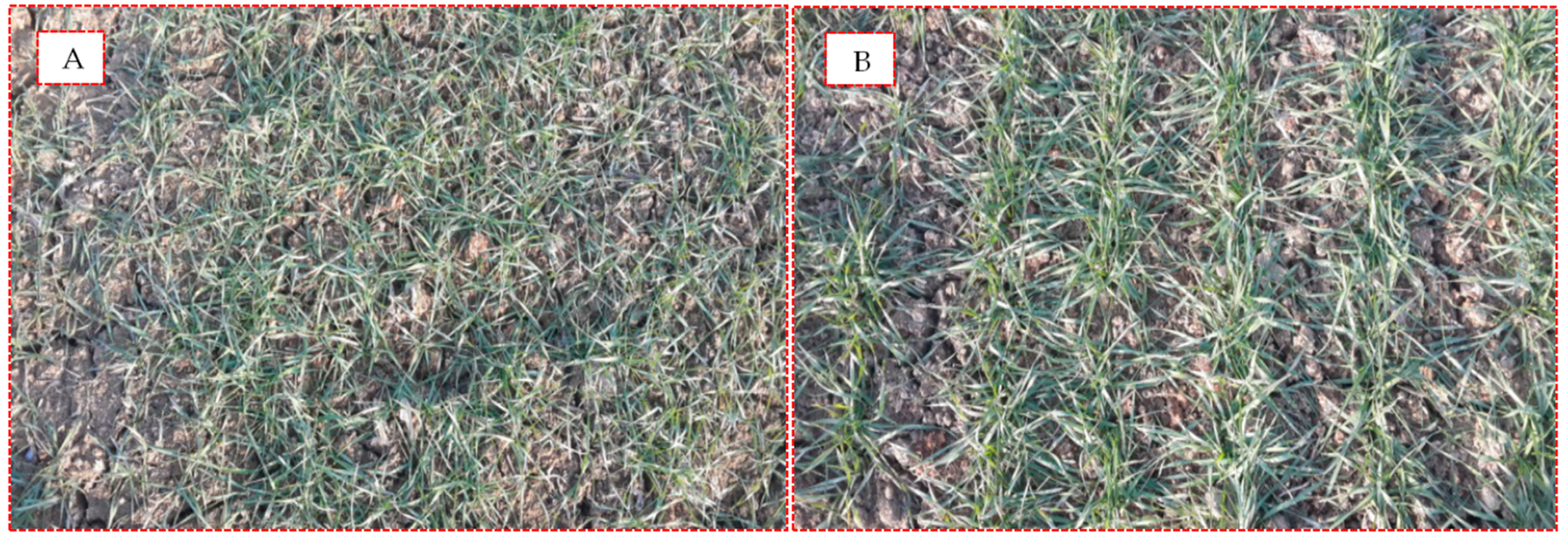
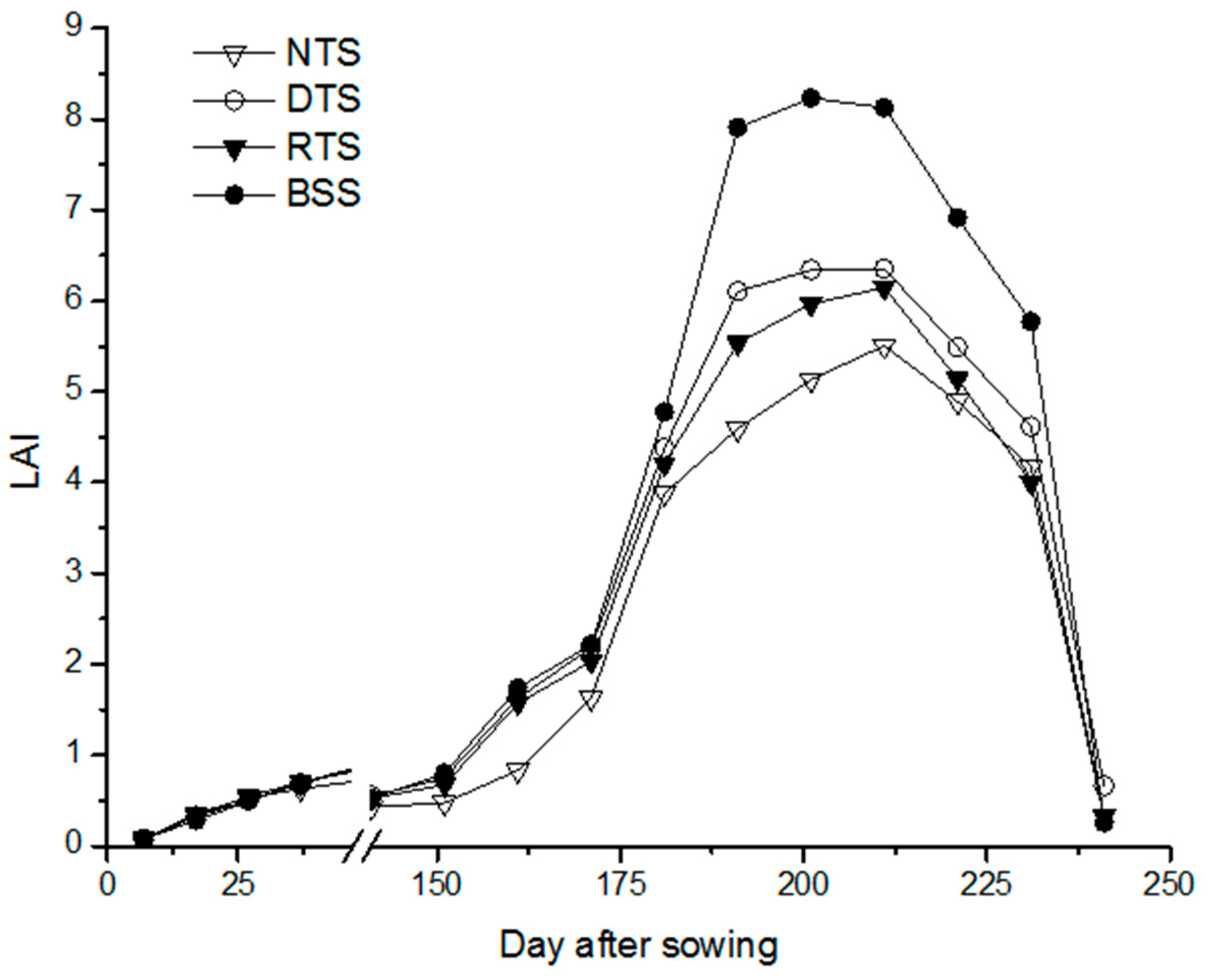
| Year | Treatment | Tillage and Seeding Efficiency (ha−1·h−1) | Sowing Depth (cm) | Effective Coverage Ratio (%) | 0–10 cm Depth Soil Water Content (%) | Emergence Rate (%) |
|---|---|---|---|---|---|---|
| 2011/2012 | NTS | 0.47 | 3.79aA | 98.98aA | 28.09aA | 89.03aA |
| DTS | 0.15 | 3.28aA | 98.89aA | 22.18bB | 86.03bB | |
| RTS | 0.17 | 3.14aA | 98.90aA | 22.67bB | 85.58bB | |
| BSS | 0.50 | 4.16aA | 89.92bB | 20.91bB | 63.98cC | |
| 2012/2013 | NTS | 0.47 | 3.80aA | 99.01aA | 25.66aA | 87.20aA |
| DTS | 0.15 | 2.39bA | 98.88aA | 19.46bB | 84.28bB | |
| RTS | 0.17 | 2.55bA | 98.85aA | 19.80bB | 83.95bB | |
| BSS | 0.53 | 2.56bA | 91.42bB | 19.15bB | 68.65cC |
| Year | Treatment | Sowing (BBCH00) | Emergence (BBCH10) | Wintering (BBCH23) | Revival (BBCH23) | Jointing (BBCH31) | Heading (BBCH54) | Filling (BBCH73) | Maturity (BBCH92) |
|---|---|---|---|---|---|---|---|---|---|
| 2011/2012 | NTS | October-11 | October-20 | November-29 | March-7 | April-8 | May-2 | May-18 | June-11 |
| DTS | October-11 | October-21 | November-29 | March-4 | April-6 | April-30 | May-16 | June-11 | |
| RTS | October-11 | October-21 | November-29 | March-4 | April-6 | April-30 | May-16 | June-10 | |
| BSS | October-11 | October-22 | November-29 | March-3 | April-7 | May-1 | May-16 | June-10 | |
| 2012/2013 | NTS | October-10 | October-19 | November-28 | March-5 | April-8 | May-6 | May-22 | June-11 |
| DTS | October-10 | October-20 | November-28 | March-3 | April-6 | May-5 | May-20 | June-11 | |
| RTS | October-10 | October-20 | November-28 | March-3 | April-6 | May-5 | May-20 | June-10 | |
| BSS | October-10 | October-19 | November-28 | March-2 | April-7 | May-6 | May-21 | June-10 |
| Year | Treatment | Dynamic of Tillers/(104·ha−1) | Earbearing Tiller Percentage | ||||||
|---|---|---|---|---|---|---|---|---|---|
| Basic Seedlings | Before Wintering | Revival | Jointing | Heading | Filling | Maturity | |||
| 2011/2012 | NTS | 607.7aA | 1146.3bB | 1300.4dC | 2279.1cC | 1254.8bB | 641.9bB | 554.7cC | 24.3 |
| DTS | 516.7bB | 1716.1aA | 1787.3bB | 2460.1bB | 1199.4cBC | 629.1bB | 587.9bB | 23.9 | |
| RTS | 514.5bB | 1639.6aA | 1752.6cB | 2404.8bB | 1185.2cC | 594.6cC | 548.4cC | 22.8 | |
| BSS | 472.3bB | 1727.5aA | 1988.4aA | 3096.1aA | 1441.2aA | 790.2aA | 657.0aA | 21.2 | |
| 2012/2013 | NTS | 610.9aA | 949.6dD | 1185.1cC | 1985.7dC | 1139.2cC | 757.5dC | 705.8cC | 35.5 |
| DTS | 562.5bAB | 1484.5aA | 1788.5aA | 2397.2bB | 1193.4bB | 810.0bB | 738.8bB | 30.8 | |
| RTS | 547.5bAB | 1339.3bB | 1610.0bB | 2315.4cB | 1151.7cBC | 775.9cC | 717.8cC | 31.0 | |
| BSS | 528.4bB | 1232.8cC | 1643.5bB | 3199.7aA | 1506.7aA | 930.0aA | 799.8aA | 25.0 | |
| Year | Treatment | Dry matter accumulation of each growing stage (kg·ha−1) | ||||||||||
|---|---|---|---|---|---|---|---|---|---|---|---|---|
| Before Wintering | % | Wintering | % | Revival to jointing | % | Jointing to Heading | % | Heading to Maturity | % | Whole Growth Period | ||
| 2011/2012 | NTS | 899.0 | 6.0 | −240.2 | −1.6 | 1830.5 | 12.3 | 5286.0 | 35.5 | 7095.9 | 47.7 | 14,871.1 |
| DTS | 1084.0 | 6.9 | −280.2 | −1.8 | 2545.2 | 16.2 | 5473.4 | 34.9 | 6858.4 | 43.7 | 15,680.7 | |
| RTS | 1075.3 | 7.1 | −290.2 | −1.9 | 2450.0 | 16.1 | 5370.7 | 35.3 | 6631.9 | 43.6 | 15,222.5 | |
| BSS | 1165.1 | 6.7 | −455.2 | −2.6 | 3065.3 | 17.7 | 6197.9 | 35.9 | 7305.5 | 42.3 | 17,278.6 | |
| 2012/2013 | NTS | 1126.6 | 5.9 | −250.8 | −1.3 | 2602.2 | 13.7 | 6141.5 | 32.4 | 9362.3 | 49.3 | 18,981.7 |
| DTS | 1270.3 | 6.4 | −273.7 | −1.4 | 3561.4 | 17.9 | 6314.0 | 31.8 | 8989.3 | 45.3 | 19,861.3 | |
| RTS | 1243.1 | 6.3 | −279.6 | −1.4 | 3481.1 | 17.7 | 6288.9 | 32.0 | 8939.5 | 45.4 | 19,673.1 | |
| BSS | 1301.0 | 5.9 | −423.6 | −1.9 | 4168.1 | 19.0 | 7050.2 | 32.2 | 9795.1 | 44.7 | 21,890.8 | |
| Season | Treatment | Productive Tillers (104·ha−1) | Grains per Spike | 1000-kernel Weight (g) | Yield | Harvest Index |
|---|---|---|---|---|---|---|
| (kg·ha−1) | ||||||
| 2011/2012 | NTS | 554.8cC | 29.0a | 40.5a | 6323.8dD | 0.43B |
| DTS | 587.9bB | 30.0a | 40.5a | 6812.4bB | 0.43B | |
| RTS | 548.4cC | 29.6a | 40.4a | 6541.5cC | 0.43B | |
| BSS | 657.0aA | 29.1a | 40.2a | 7599.0aA | 0.44A | |
| 2012/2013 | NTS | 705.8dC | 30.8a | 37.1bB | 8010.3cC | 0.42cC |
| DTS | 738.8bB | 31.4a | 39.4aA | 8639.7bB | 0.44bB | |
| RTS | 717.8cC | 31.7a | 39.2aA | 8439.7bB | 0.43bB | |
| BSS | 799.8aA | 31.3a | 39.1aA | 9763.3aA | 0.45A |
© 2018 by the authors. Licensee MDPI, Basel, Switzerland. This article is an open access article distributed under the terms and conditions of the Creative Commons Attribution (CC BY) license (http://creativecommons.org/licenses/by/4.0/).
Share and Cite
Zhai, Y.; Wu, Q.; Chen, G.; Zhang, H.; Yin, X.; Chen, F. Broadcasting Winter Wheat Can Increase Grain Yield without Reducing the Kernels per Spike and the Kernel Weight. Sustainability 2018, 10, 4858. https://doi.org/10.3390/su10124858
Zhai Y, Wu Q, Chen G, Zhang H, Yin X, Chen F. Broadcasting Winter Wheat Can Increase Grain Yield without Reducing the Kernels per Spike and the Kernel Weight. Sustainability. 2018; 10(12):4858. https://doi.org/10.3390/su10124858
Chicago/Turabian StyleZhai, Yunlong, Quanzhong Wu, Guodong Chen, Hailin Zhang, Xiaogang Yin, and Fu Chen. 2018. "Broadcasting Winter Wheat Can Increase Grain Yield without Reducing the Kernels per Spike and the Kernel Weight" Sustainability 10, no. 12: 4858. https://doi.org/10.3390/su10124858
APA StyleZhai, Y., Wu, Q., Chen, G., Zhang, H., Yin, X., & Chen, F. (2018). Broadcasting Winter Wheat Can Increase Grain Yield without Reducing the Kernels per Spike and the Kernel Weight. Sustainability, 10(12), 4858. https://doi.org/10.3390/su10124858






